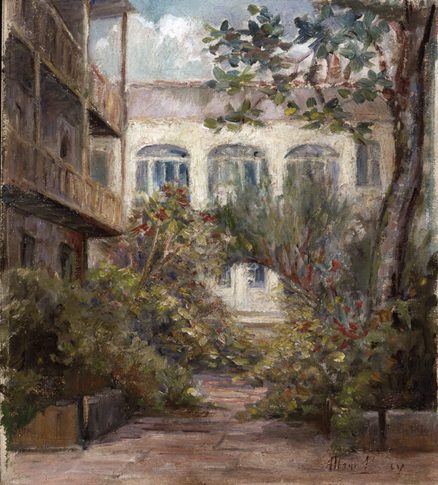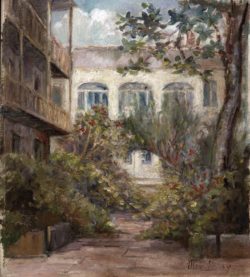Alberta Kinsey
Alberta Kinsey settled in New Orleans in the 1920s where she was actively associated with the French Quarter Renaissance.

Courtesy of The Historic New Orleans Collection
Christian Woman's Exchange. Kinsey, Alberta (Artist)
Alberta Kinsey, a modest Quaker schoolteacher from the Midwest, fell in love with the French Quarter the first day she arrived in 1918. She is credited with inventing the enduring “courtyard” genre of painting—widely copied scenes of the picturesque interior green spaces common in the Spanish-colonial buildings of the Vieux Carré. She was among the first artists to live in the then dangerous and derelict Quarter, encouraging and paving the way for others by renting studio space, and cofounding the Arts and Crafts Club of New Orleans in 1922, an organization which provided art training and exhibition space and hosted guest lecturers on current art topics.
Early Years
Kinsey was born in 1875 on a small farm in Milton, Ohio, the first child of David and Lydia Kinsey, and attended school in a rural one-room schoolhouse with her three younger brothers. Kinsey began her adult life as a teacher in a similar school, and after training at the Cincinnati Art Academy in Ohio and the Chicago Art School in Illinois she taught studio courses at Lebanon University in Lebanon, Ohio. In 1918, when the college was forced to close during World War I, Kinsey moved to New Orleans. Although she was said to have had a scholarship from Newcomb College, Kinsey recalled that her attraction to the city was because ”the name pleased me” and that “it was warm here.” Kinsey’s taking up residence in the French Quarter in the late 1910s was a rarity for a single woman of her background. The neighborhood was largely a slum inhabited by newly arrived immigrants, with many rowdy saloons that catered to sailors and wharf laborers, but Kinsey remained there for thirty-three years as a staunch advocate of its restoration.
The Beginning of the French Quarter Art Colony
Kinsey’s earliest supporter was Lyle Saxon, a writer and journalist for the Times-Picayune and a stalwart crusader for the rehabilitation the French Quarter. Saxon envisioned the creation of an art colony and invited his friends, artists, and writers to join him. Kinsey’s early years in New Orleans were difficult, but she remained unswerving in her artistic vision: “When I came to New Orleans, I wanted to paint,” she said. “I didn’t have a great talent or the genius for it, but I did have the desire. It was love at first sight, even before I had seen a patio or mounted a creaky stair in the old houses I love so much.”
Kinsey’s studio at 628 Toulouse Street was the site of the first formal art class among the burgeoning bohemian art colony in the French Quarter. It was organized by artists Harry Nolan and Robert Grafton, both Indiana transplants. This was the start of the long-lived Arts and Crafts Club of New Orleans, which subsequently found a more permanent home in the old Maison Seignouret at 520 Royal Street. Kinsey later bought and renovated the landmark Daniel Clark Home at 823 Royal Street.
Painting Style
Kinsey’s style was usually a loose painterly realism with a respect for underlying form. Her palette was natural, with warm, saturated color. After her travels in Europe in the 1920s, and as a response to modern art movements, she experimented with conventionalized form and flattened space to the point of abstraction in some paintings. Of this change in style, she explained, “I’ve painted about every patio in the Quarter, but once a year I just must try contemporary painting. I just love the patios, like you feel for an old sweetheart — but nonobjective art is like a new beau. Those paintings don’t mean anything. If I put a line here, it calls for another one there — and then another one over there. I hope the change of pace will help me do a better job on the patios.”
Later Years
Always the advocate for the arts, Alberta Kinsey is credited with inspiring the Cane River primitive painter Clementine Hunter. Kinsey was a frequent guest at Melrose Plantation, the home of John Hampton and Cammie Henry, where she painted her favorite magnolia blooms and the surrounding countryside. In 1940, she apparently had left out her paints and brushes, an oversight prompting Hunter to pursue painting. From Kinsey’s correspondence, however, it is clear that she gave Clementine some instruction and a lot of encouragement.
When the Arts and Crafts Club of New Orleans closed its doors in 1951, it was the end of an era, yet Kinsey could look upon her beloved French Quarter and see it revitalized. From her early and daring commitment to living in the Vieux Carré and her personal restoration of a landmark, she labored constantly to preserve the colonial district from destruction. When she died the following year in New Orleans, she was remembered as a preservationist, the founding figure of the city’s art colony, and as the creator of one of the most enduring subjects of French Quarter art, the courtyard scene. Her art may be found in the New Orleans Museum of Art, The Historic New Orleans Collection, and the Ogden Museum of Southern Art in New Orleans.
